Case Study – Auditing 5: Auditor Independence and Threats
VerifiedAdded on 2022/08/31
|8
|1217
|17
Case Study
AI Summary
This case study analyzes the auditor's independence in the context of Peechee Ltd and the audit firm PDW. It explores three potential issues: the long-standing relationship between PDW and Peechee Ltd, the new engagement partner's financial interest in the client company, and the provision of non-audit services. The study identifies threats such as familiarity, self-interest, and self-review, along with relevant rules and regulations from APES 110. Recommendations are provided to mitigate these threats, including a cooling-off period, avoiding partners with financial interests, and ensuring non-audit services are performed by separate teams. The conclusion emphasizes the importance of adhering to ethical codes and regulations to maintain auditor independence and suggests that, based on the case details, the audit should not be accepted.
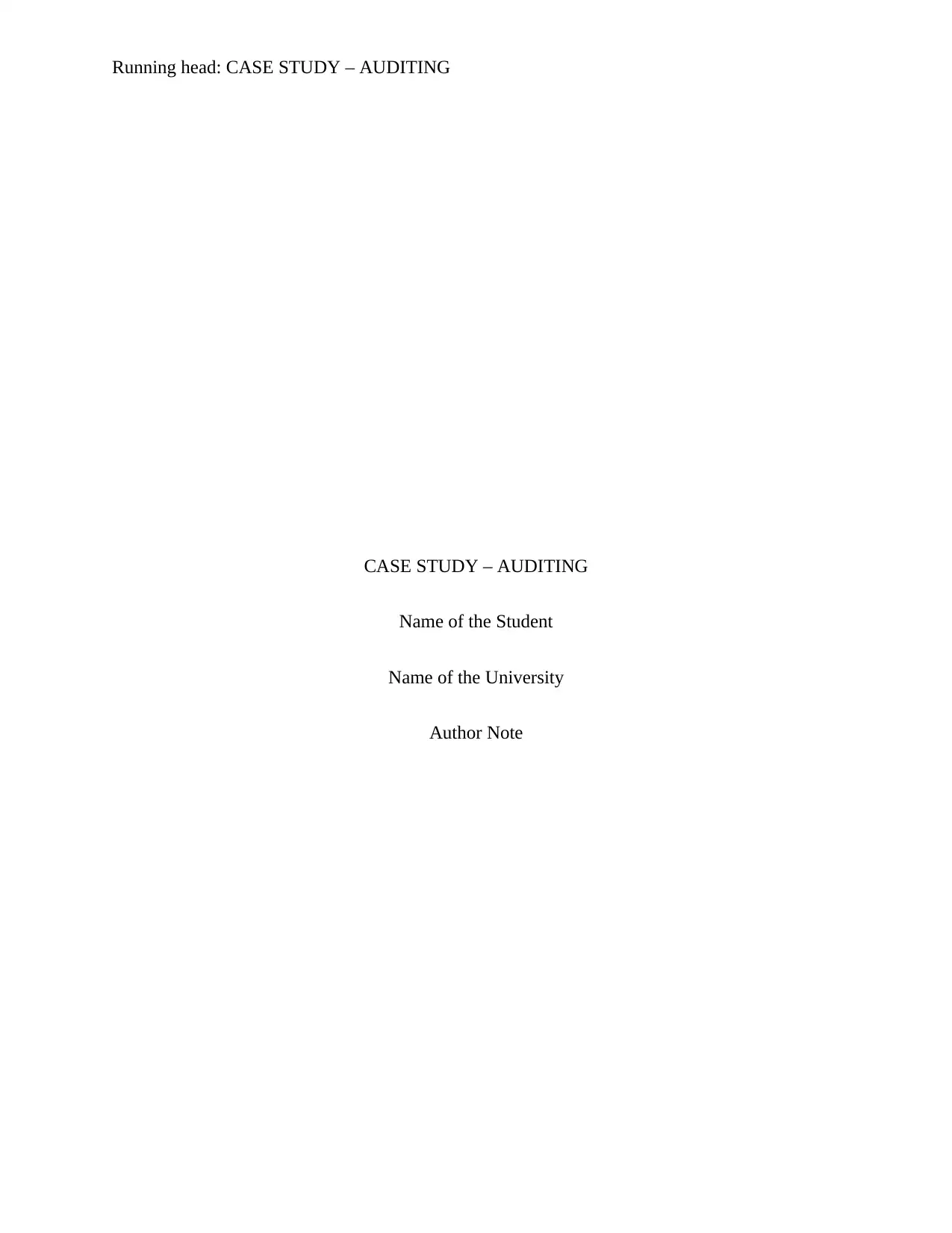
Running head: CASE STUDY – AUDITING
CASE STUDY – AUDITING
Name of the Student
Name of the University
Author Note
CASE STUDY – AUDITING
Name of the Student
Name of the University
Author Note
Paraphrase This Document
Need a fresh take? Get an instant paraphrase of this document with our AI Paraphraser
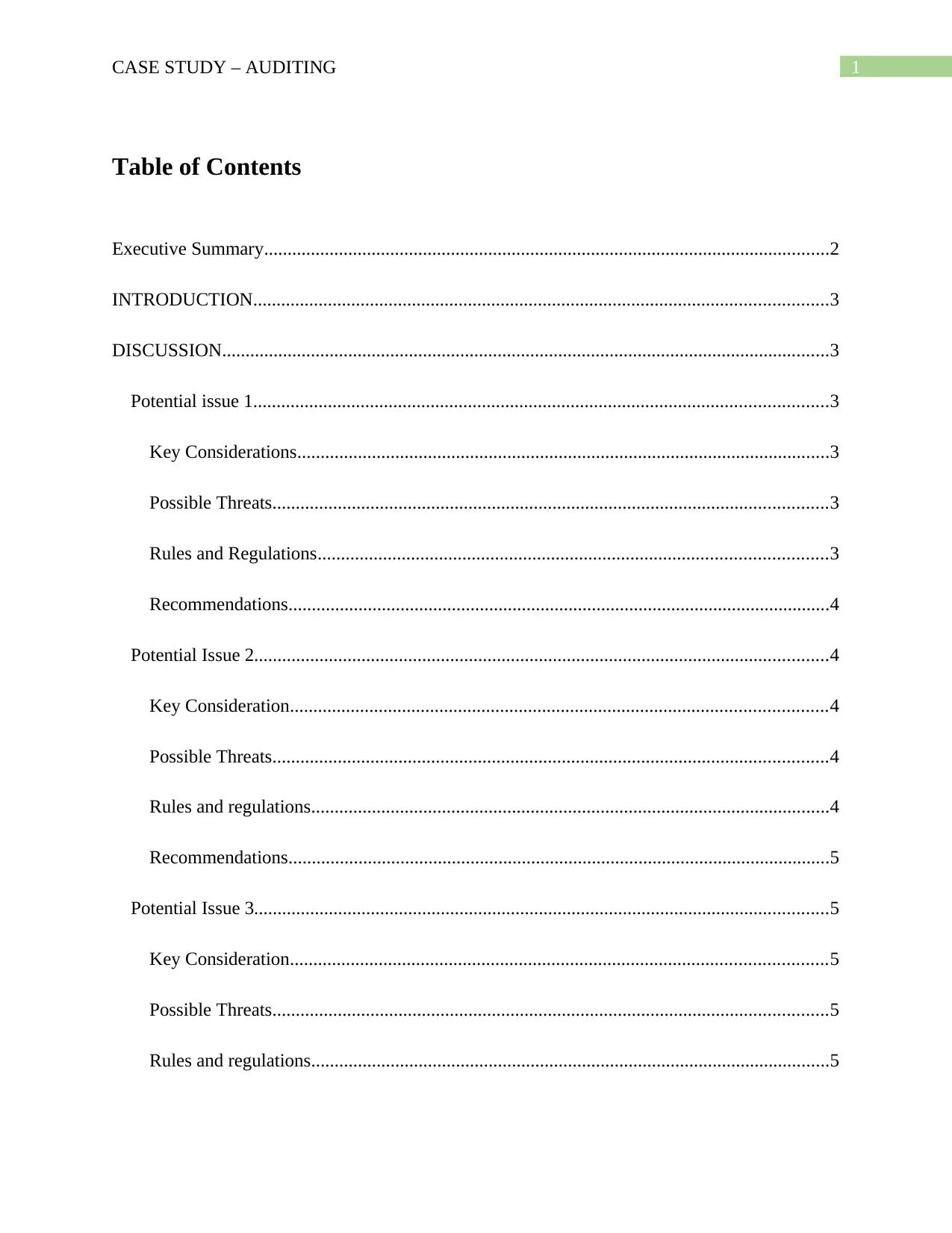
1CASE STUDY – AUDITING
Table of Contents
Executive Summary.........................................................................................................................2
INTRODUCTION...........................................................................................................................3
DISCUSSION..................................................................................................................................3
Potential issue 1...........................................................................................................................3
Key Considerations..................................................................................................................3
Possible Threats.......................................................................................................................3
Rules and Regulations.............................................................................................................3
Recommendations....................................................................................................................4
Potential Issue 2...........................................................................................................................4
Key Consideration...................................................................................................................4
Possible Threats.......................................................................................................................4
Rules and regulations...............................................................................................................4
Recommendations....................................................................................................................5
Potential Issue 3...........................................................................................................................5
Key Consideration...................................................................................................................5
Possible Threats.......................................................................................................................5
Rules and regulations...............................................................................................................5
Table of Contents
Executive Summary.........................................................................................................................2
INTRODUCTION...........................................................................................................................3
DISCUSSION..................................................................................................................................3
Potential issue 1...........................................................................................................................3
Key Considerations..................................................................................................................3
Possible Threats.......................................................................................................................3
Rules and Regulations.............................................................................................................3
Recommendations....................................................................................................................4
Potential Issue 2...........................................................................................................................4
Key Consideration...................................................................................................................4
Possible Threats.......................................................................................................................4
Rules and regulations...............................................................................................................4
Recommendations....................................................................................................................5
Potential Issue 3...........................................................................................................................5
Key Consideration...................................................................................................................5
Possible Threats.......................................................................................................................5
Rules and regulations...............................................................................................................5
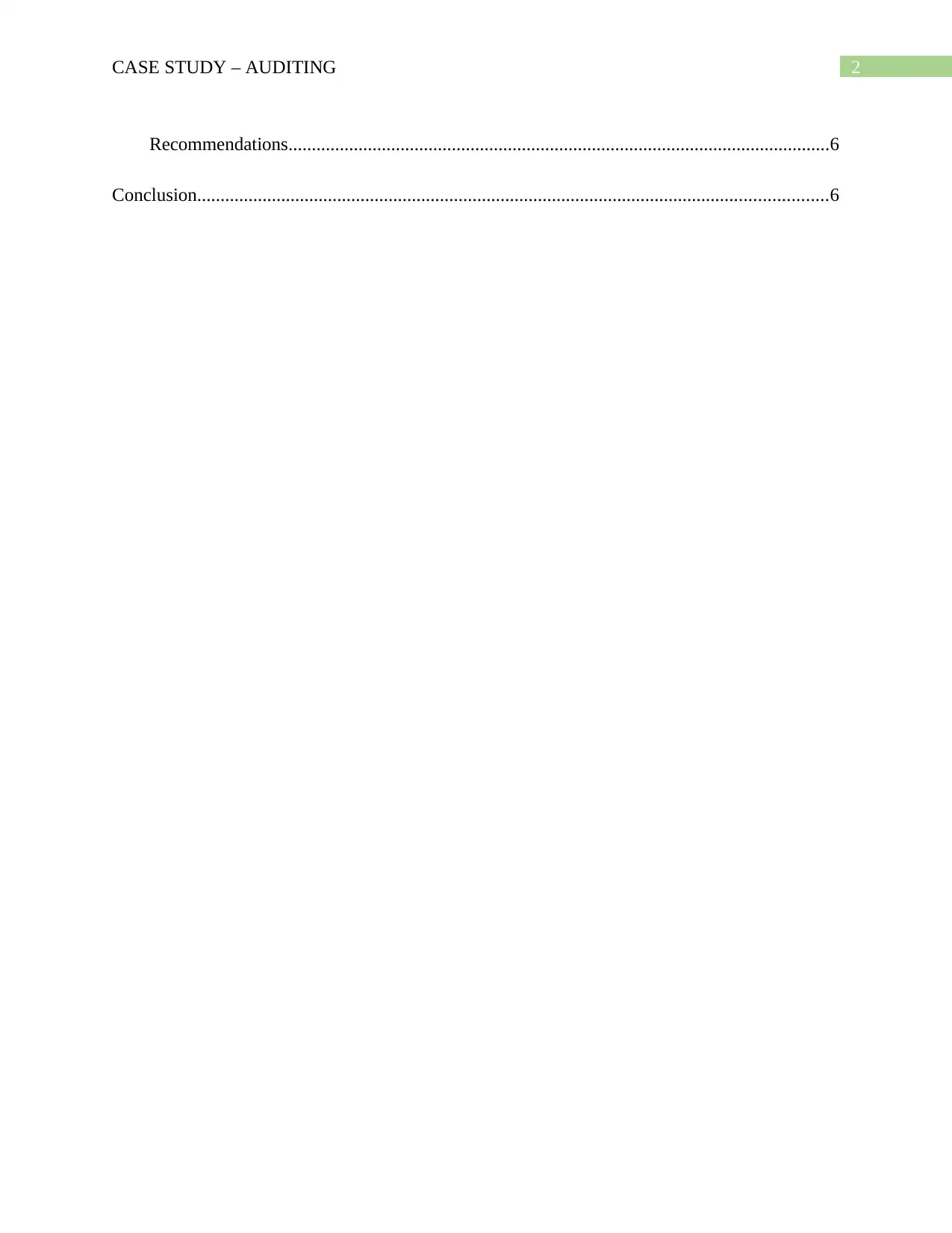
2CASE STUDY – AUDITING
Recommendations....................................................................................................................6
Conclusion.......................................................................................................................................6
Recommendations....................................................................................................................6
Conclusion.......................................................................................................................................6
⊘ This is a preview!⊘
Do you want full access?
Subscribe today to unlock all pages.

Trusted by 1+ million students worldwide

3CASE STUDY – AUDITING
Executive Summary
This project aims to provide the importance of auditor’s independence in forming an audit
opinion, assessment of threats, their impact, and chances of misstatement. The project is based
on the analysis of the case study on Peechee Ltd, a public listed company, and PDW (audit firm).
This project will focus on deciding whether to continue or not with the audit client. There are
also some recommendations made to Pines, Deng & Woods (PDW) based on the emergence of
probable threats to reduce the chances of threats to an acceptably low level.
The first potential issue identified is that they are auditing the company for the past ten years,
and this will be the 11th consecutive year, which is not as per the regulations and will impose
threats on independence and also a breach of Act. The recommendation is that there has to be an
appropriate cooling period service, proper review by an independent partner, follow the code of
ethics, and relevant section. The second potential issue is that the new probable engagement
audit partner holds 1000 shares in the client company, and it will impose self-interest threats.
The recommendation is not to appoint such an engagement partner who holds a financial interest
in the company. The third potential issue is receiving non-audit services and taking technical
assistance for financial statement, that is for valuation of inventory management service. The
recommendation is that service must be performed by a non-audit team member.
It is to be concluded that if the code of ethics and all the rules and regulations of the relevant
sections are to be followed, there will be no such threats materializing, and auditor might form an
independent opinion. But in the given case study, it is advisable not to accept this audit and to
take a cooling-off period to avoid any prohibition of rules and regulations.
Executive Summary
This project aims to provide the importance of auditor’s independence in forming an audit
opinion, assessment of threats, their impact, and chances of misstatement. The project is based
on the analysis of the case study on Peechee Ltd, a public listed company, and PDW (audit firm).
This project will focus on deciding whether to continue or not with the audit client. There are
also some recommendations made to Pines, Deng & Woods (PDW) based on the emergence of
probable threats to reduce the chances of threats to an acceptably low level.
The first potential issue identified is that they are auditing the company for the past ten years,
and this will be the 11th consecutive year, which is not as per the regulations and will impose
threats on independence and also a breach of Act. The recommendation is that there has to be an
appropriate cooling period service, proper review by an independent partner, follow the code of
ethics, and relevant section. The second potential issue is that the new probable engagement
audit partner holds 1000 shares in the client company, and it will impose self-interest threats.
The recommendation is not to appoint such an engagement partner who holds a financial interest
in the company. The third potential issue is receiving non-audit services and taking technical
assistance for financial statement, that is for valuation of inventory management service. The
recommendation is that service must be performed by a non-audit team member.
It is to be concluded that if the code of ethics and all the rules and regulations of the relevant
sections are to be followed, there will be no such threats materializing, and auditor might form an
independent opinion. But in the given case study, it is advisable not to accept this audit and to
take a cooling-off period to avoid any prohibition of rules and regulations.
Paraphrase This Document
Need a fresh take? Get an instant paraphrase of this document with our AI Paraphraser
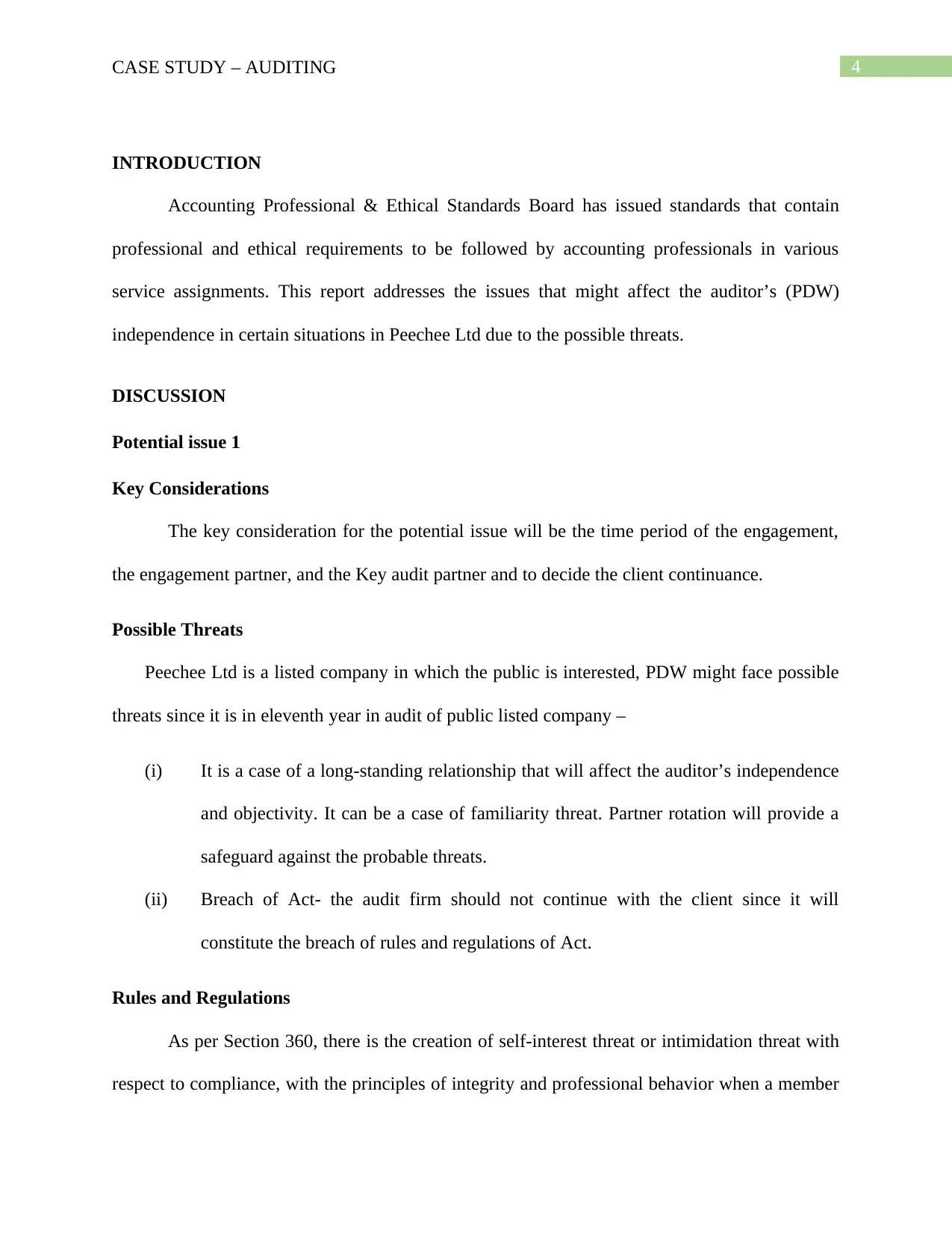
4CASE STUDY – AUDITING
INTRODUCTION
Accounting Professional & Ethical Standards Board has issued standards that contain
professional and ethical requirements to be followed by accounting professionals in various
service assignments. This report addresses the issues that might affect the auditor’s (PDW)
independence in certain situations in Peechee Ltd due to the possible threats.
DISCUSSION
Potential issue 1
Key Considerations
The key consideration for the potential issue will be the time period of the engagement,
the engagement partner, and the Key audit partner and to decide the client continuance.
Possible Threats
Peechee Ltd is a listed company in which the public is interested, PDW might face possible
threats since it is in eleventh year in audit of public listed company –
(i) It is a case of a long-standing relationship that will affect the auditor’s independence
and objectivity. It can be a case of familiarity threat. Partner rotation will provide a
safeguard against the probable threats.
(ii) Breach of Act- the audit firm should not continue with the client since it will
constitute the breach of rules and regulations of Act.
Rules and Regulations
As per Section 360, there is the creation of self-interest threat or intimidation threat with
respect to compliance, with the principles of integrity and professional behavior when a member
INTRODUCTION
Accounting Professional & Ethical Standards Board has issued standards that contain
professional and ethical requirements to be followed by accounting professionals in various
service assignments. This report addresses the issues that might affect the auditor’s (PDW)
independence in certain situations in Peechee Ltd due to the possible threats.
DISCUSSION
Potential issue 1
Key Considerations
The key consideration for the potential issue will be the time period of the engagement,
the engagement partner, and the Key audit partner and to decide the client continuance.
Possible Threats
Peechee Ltd is a listed company in which the public is interested, PDW might face possible
threats since it is in eleventh year in audit of public listed company –
(i) It is a case of a long-standing relationship that will affect the auditor’s independence
and objectivity. It can be a case of familiarity threat. Partner rotation will provide a
safeguard against the probable threats.
(ii) Breach of Act- the audit firm should not continue with the client since it will
constitute the breach of rules and regulations of Act.
Rules and Regulations
As per Section 360, there is the creation of self-interest threat or intimidation threat with
respect to compliance, with the principles of integrity and professional behavior when a member
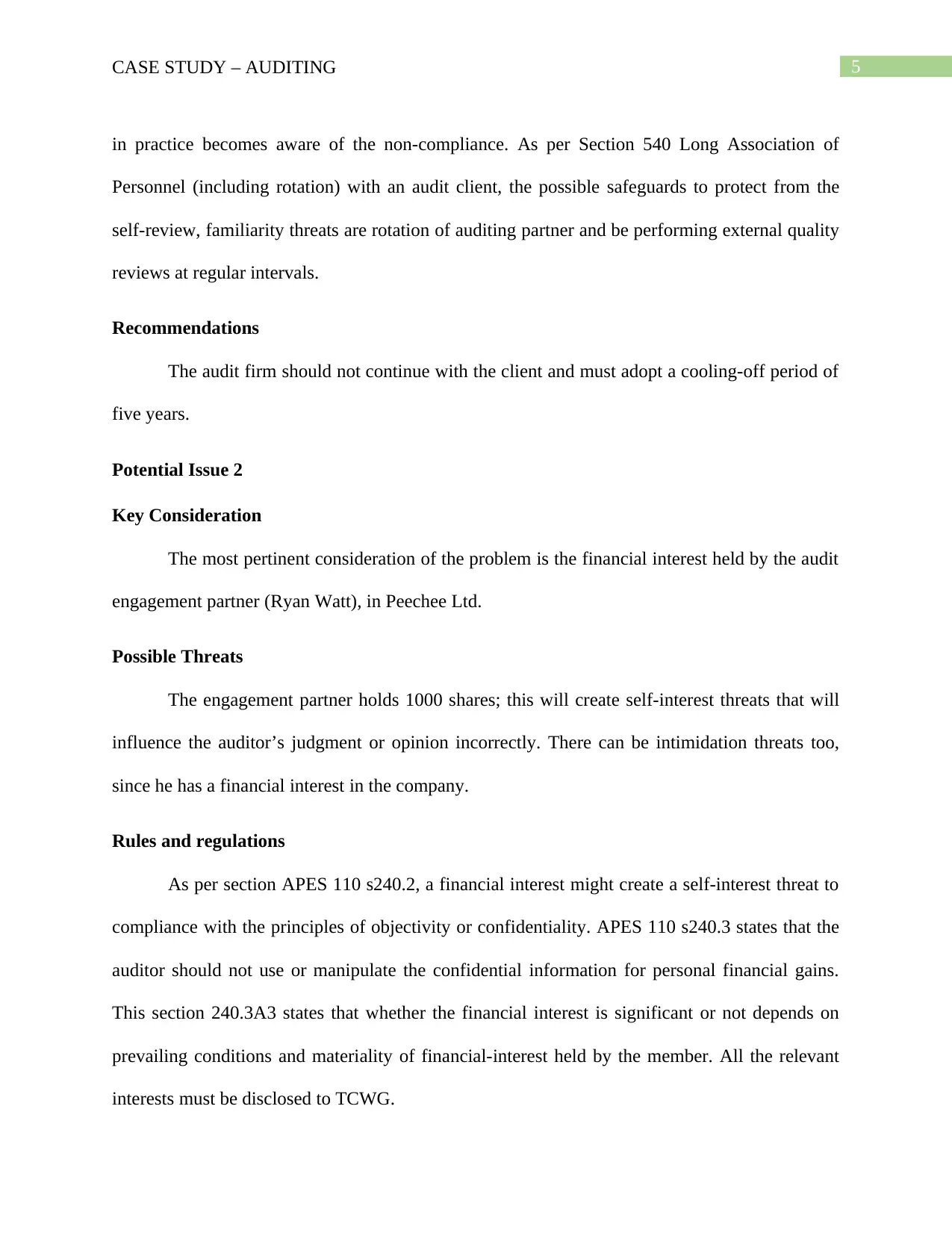
5CASE STUDY – AUDITING
in practice becomes aware of the non-compliance. As per Section 540 Long Association of
Personnel (including rotation) with an audit client, the possible safeguards to protect from the
self-review, familiarity threats are rotation of auditing partner and be performing external quality
reviews at regular intervals.
Recommendations
The audit firm should not continue with the client and must adopt a cooling-off period of
five years.
Potential Issue 2
Key Consideration
The most pertinent consideration of the problem is the financial interest held by the audit
engagement partner (Ryan Watt), in Peechee Ltd.
Possible Threats
The engagement partner holds 1000 shares; this will create self-interest threats that will
influence the auditor’s judgment or opinion incorrectly. There can be intimidation threats too,
since he has a financial interest in the company.
Rules and regulations
As per section APES 110 s240.2, a financial interest might create a self-interest threat to
compliance with the principles of objectivity or confidentiality. APES 110 s240.3 states that the
auditor should not use or manipulate the confidential information for personal financial gains.
This section 240.3A3 states that whether the financial interest is significant or not depends on
prevailing conditions and materiality of financial-interest held by the member. All the relevant
interests must be disclosed to TCWG.
in practice becomes aware of the non-compliance. As per Section 540 Long Association of
Personnel (including rotation) with an audit client, the possible safeguards to protect from the
self-review, familiarity threats are rotation of auditing partner and be performing external quality
reviews at regular intervals.
Recommendations
The audit firm should not continue with the client and must adopt a cooling-off period of
five years.
Potential Issue 2
Key Consideration
The most pertinent consideration of the problem is the financial interest held by the audit
engagement partner (Ryan Watt), in Peechee Ltd.
Possible Threats
The engagement partner holds 1000 shares; this will create self-interest threats that will
influence the auditor’s judgment or opinion incorrectly. There can be intimidation threats too,
since he has a financial interest in the company.
Rules and regulations
As per section APES 110 s240.2, a financial interest might create a self-interest threat to
compliance with the principles of objectivity or confidentiality. APES 110 s240.3 states that the
auditor should not use or manipulate the confidential information for personal financial gains.
This section 240.3A3 states that whether the financial interest is significant or not depends on
prevailing conditions and materiality of financial-interest held by the member. All the relevant
interests must be disclosed to TCWG.
⊘ This is a preview!⊘
Do you want full access?
Subscribe today to unlock all pages.

Trusted by 1+ million students worldwide
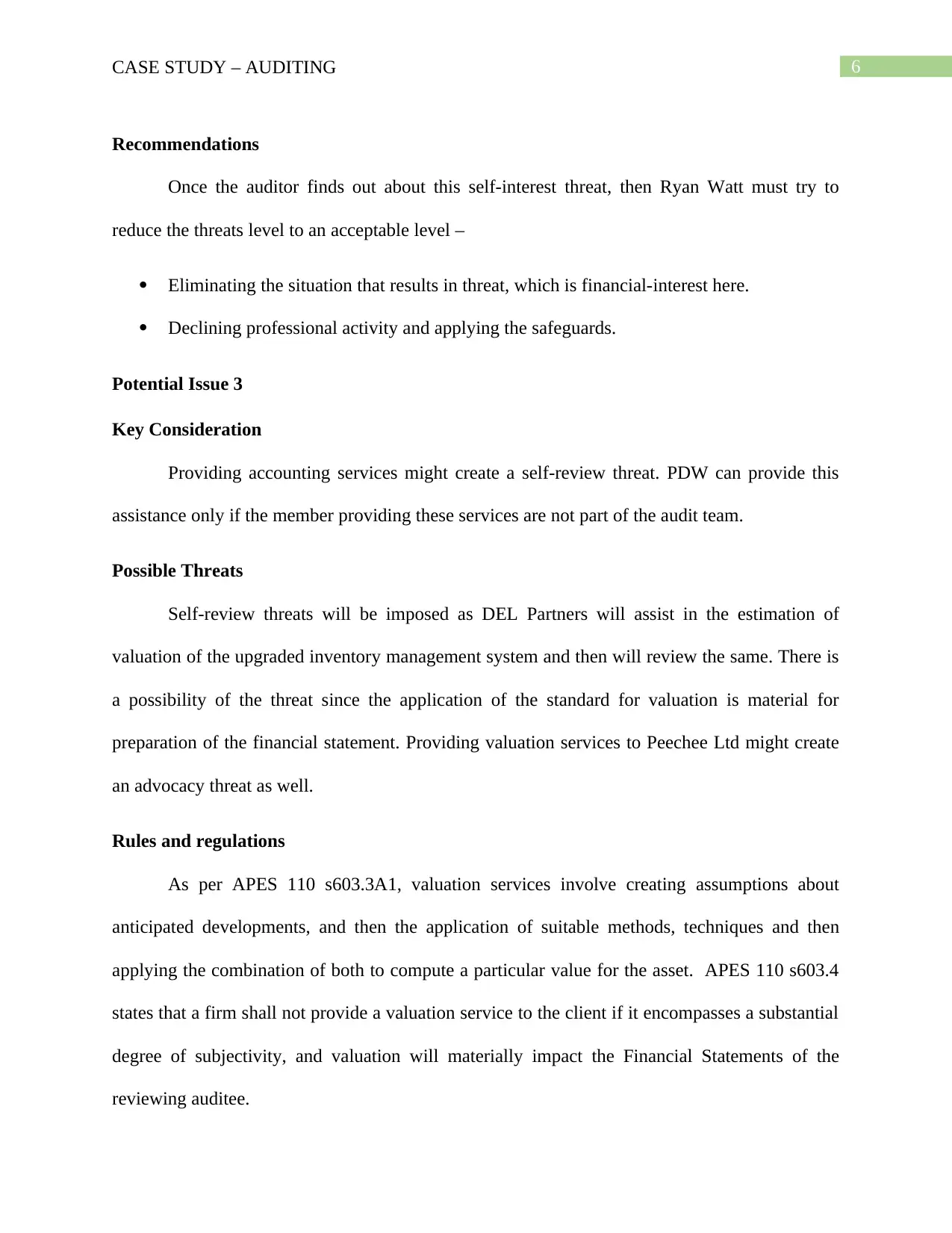
6CASE STUDY – AUDITING
Recommendations
Once the auditor finds out about this self-interest threat, then Ryan Watt must try to
reduce the threats level to an acceptable level –
Eliminating the situation that results in threat, which is financial-interest here.
Declining professional activity and applying the safeguards.
Potential Issue 3
Key Consideration
Providing accounting services might create a self-review threat. PDW can provide this
assistance only if the member providing these services are not part of the audit team.
Possible Threats
Self-review threats will be imposed as DEL Partners will assist in the estimation of
valuation of the upgraded inventory management system and then will review the same. There is
a possibility of the threat since the application of the standard for valuation is material for
preparation of the financial statement. Providing valuation services to Peechee Ltd might create
an advocacy threat as well.
Rules and regulations
As per APES 110 s603.3A1, valuation services involve creating assumptions about
anticipated developments, and then the application of suitable methods, techniques and then
applying the combination of both to compute a particular value for the asset. APES 110 s603.4
states that a firm shall not provide a valuation service to the client if it encompasses a substantial
degree of subjectivity, and valuation will materially impact the Financial Statements of the
reviewing auditee.
Recommendations
Once the auditor finds out about this self-interest threat, then Ryan Watt must try to
reduce the threats level to an acceptable level –
Eliminating the situation that results in threat, which is financial-interest here.
Declining professional activity and applying the safeguards.
Potential Issue 3
Key Consideration
Providing accounting services might create a self-review threat. PDW can provide this
assistance only if the member providing these services are not part of the audit team.
Possible Threats
Self-review threats will be imposed as DEL Partners will assist in the estimation of
valuation of the upgraded inventory management system and then will review the same. There is
a possibility of the threat since the application of the standard for valuation is material for
preparation of the financial statement. Providing valuation services to Peechee Ltd might create
an advocacy threat as well.
Rules and regulations
As per APES 110 s603.3A1, valuation services involve creating assumptions about
anticipated developments, and then the application of suitable methods, techniques and then
applying the combination of both to compute a particular value for the asset. APES 110 s603.4
states that a firm shall not provide a valuation service to the client if it encompasses a substantial
degree of subjectivity, and valuation will materially impact the Financial Statements of the
reviewing auditee.
Paraphrase This Document
Need a fresh take? Get an instant paraphrase of this document with our AI Paraphraser
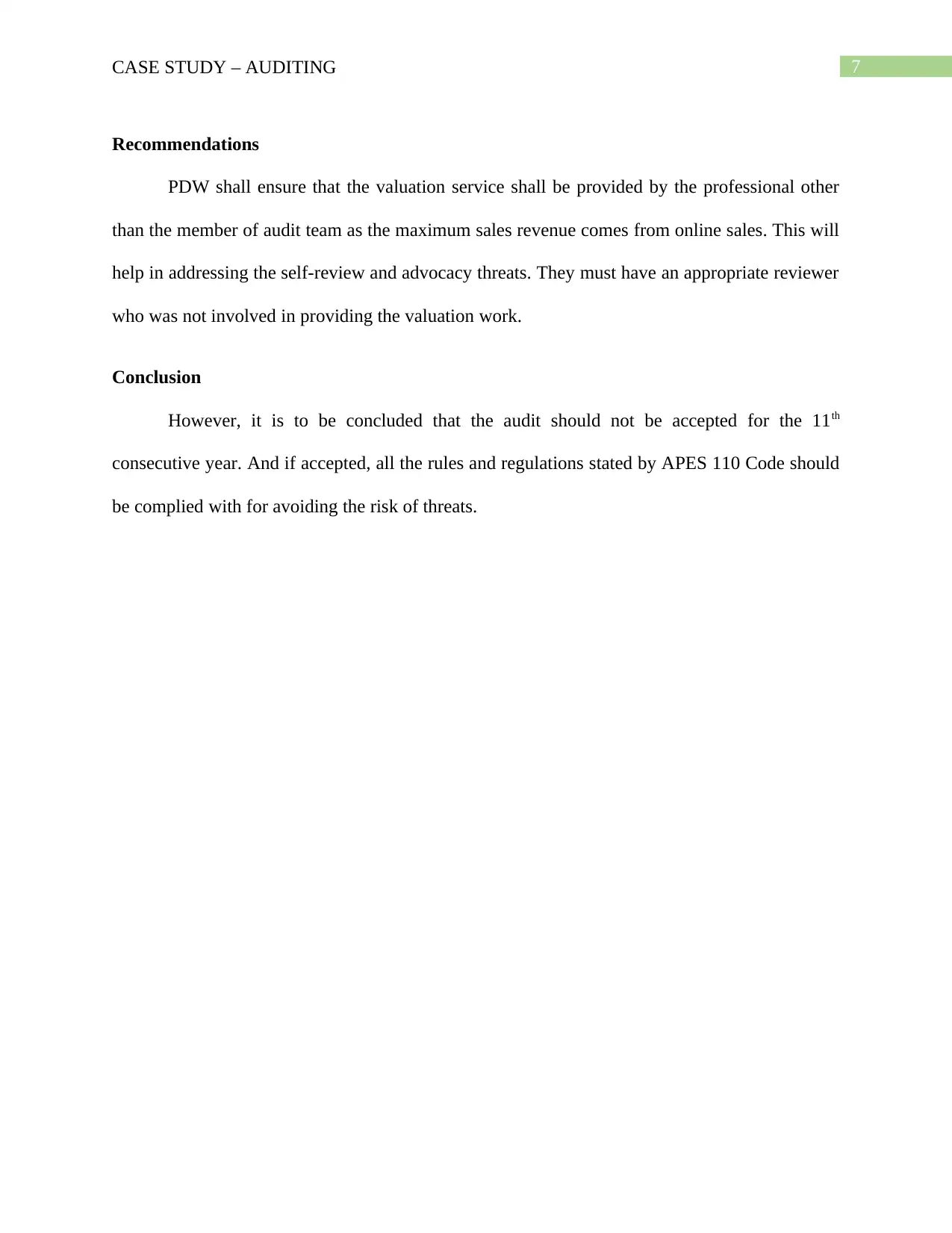
7CASE STUDY – AUDITING
Recommendations
PDW shall ensure that the valuation service shall be provided by the professional other
than the member of audit team as the maximum sales revenue comes from online sales. This will
help in addressing the self-review and advocacy threats. They must have an appropriate reviewer
who was not involved in providing the valuation work.
Conclusion
However, it is to be concluded that the audit should not be accepted for the 11th
consecutive year. And if accepted, all the rules and regulations stated by APES 110 Code should
be complied with for avoiding the risk of threats.
Recommendations
PDW shall ensure that the valuation service shall be provided by the professional other
than the member of audit team as the maximum sales revenue comes from online sales. This will
help in addressing the self-review and advocacy threats. They must have an appropriate reviewer
who was not involved in providing the valuation work.
Conclusion
However, it is to be concluded that the audit should not be accepted for the 11th
consecutive year. And if accepted, all the rules and regulations stated by APES 110 Code should
be complied with for avoiding the risk of threats.
1 out of 8
Related Documents
Your All-in-One AI-Powered Toolkit for Academic Success.
+13062052269
info@desklib.com
Available 24*7 on WhatsApp / Email
![[object Object]](/_next/static/media/star-bottom.7253800d.svg)
Unlock your academic potential
Copyright © 2020–2025 A2Z Services. All Rights Reserved. Developed and managed by ZUCOL.





